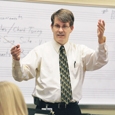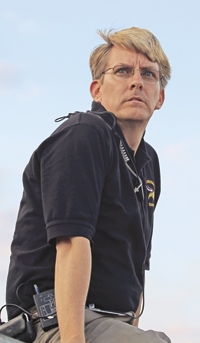 Bill Thomas has tried to instill a sense of community everywhere he has taught including 14 years as director of bands in Dodge City, Kansas and now 6 years at Shawnee Mission West High School, a school with three concert bands, two jazz bands, and various smaller ensembles. He earned a B.M.E from Pittsburg State in Kansas and an M.M.E. from Wichita State. While studying at Wichita State, Thomas gained a reputation for expertise with computers and sound engineering. One highlight from this school year was a trip to London for the annual New Year’s Parade.
Bill Thomas has tried to instill a sense of community everywhere he has taught including 14 years as director of bands in Dodge City, Kansas and now 6 years at Shawnee Mission West High School, a school with three concert bands, two jazz bands, and various smaller ensembles. He earned a B.M.E from Pittsburg State in Kansas and an M.M.E. from Wichita State. While studying at Wichita State, Thomas gained a reputation for expertise with computers and sound engineering. One highlight from this school year was a trip to London for the annual New Year’s Parade.
What do directors need to know about sound engineering?
I’ve helped install PA systems over the years and run sound at the church I attend on a digital mixing console. I have also done this for many professional groups, including the Count Basie Band when they came through town years ago. I have also done clinics for KMEA and the Kansas Bandmasters Association about how to record your group in order to produce a professional sounding recording. Often teachers do not have an understanding of how it works.
All directors should know how to turn on and work the PA system. They cannot always rely on a knowledgeable parent or students. I can’t believe how many times I have gone to a concert, and the director does not know how to use the microphone, so he ends up yelling loudly from the front of the auditorium. Just from a professional standpoint, directors should have a rudimentary understanding of sound systems.
Microphone placement is often a problem. People hold it at the belly button and somehow expect to be heard. I tell student teachers to treat the microphone like an ice cream cone and put it close to their mouth. If nothing else, they should place it next to their chin so they are talking across the top, rather than directly into it, which can produce pops that are not pretty. If the microphone is placed on the chin, it moves with you when the head turns, and sound is not lost.
Beyond the basics, teachers should know how to connect a microphone into an amplifier and into a speaker. When I work with student teachers, I address how they are going record their groups. Sound travels in a straight line. It goes in the microphone and follows a straight path out to the speaker. It is really not rocket science; you just have to understand signal flow, so I try to demystify it. I have been fooling with sound equipment since I was five years old when my dad bought me a microphone. Now it is a passion and a hobby.
What is the biggest problem you have faced this year?
Articulation is a big issue in our program. We only see the beginners twice a week so they don’t get grounded in the fundamentals like they should, so that’s one of the things that tends to slip through the cracks. By the time they get to high school, we are still fighting those nasty habits that got established and didn’t get fixed at the elementary level.
Students here begin in 5th grade. This year I teach one class of elementary level students, and my assistant at the high school and another teacher in the area work with other elementary school classes. The last time I taught beginners was ten years ago, and I saw them five days a week. This band meets two days a week for 30 minutes, which is not nearly enough time. Fortunately, my assistant, Kevin Hupe, has more experience with this level so I am leaning on him to learn how to teach students what they need in a short amount of time. Honestly, I am still trying to figure it out.
I don’t feel like I know the students as well as I should or even the staff in the elementary building. I build all of my programs on relationships, and I don’t have that with my beginners this year. Musicianship is important, but the personality of the director has a lot to do with whether students keep playing in band. It matters that students know that you really care and that teaching is not just a job to you.
I spend time each day checking embouchures trying to get the tone right. In my mind we may not be as far in the books as some other schools (our high school has nine feeder elementary schools). I feel that if they have good fundamentals, hopefully they will catch up. Daily repetition is essential for students to develop muscle memory and a good concept of tone. When you are not there to watch over that, it is hard to know how much students retain. Even as a 20-year veteran, I am having to learn again how to teach beginners.
What led you to pursue a career in music?
My brothers and sisters all played piano before me so that got me started. Somewhere along the way I saw a marching band in a parade and knew I had to do that. I was probably in third or fourth grade. We didn’t have the money for an instrument, but my aunt loaned me a cornet. The next year I started on euphonium at school and never looked back.
I attended music camps at Manhattan Christian College in Kansas and thought initially I would pursue church music. I knew I loved music but didn’t know where I was headed with it. One day I was in the band office with my director and his wife who asked, “What are you going to do with your life? Are you going to be a band director?” I responded, “of course” and at that moment the answer clicked for me.
What was your first teaching job?
I was an assistant director in the Dodge City schools, helping out at the high school and elementary schools, so I was in seven or eight buildings a day. The band program overall had about 700 students. When I looked for a first job, I wanted to be in a program where I would be surrounded with experienced teachers to take me under their wing.
As a veteran of drum corps I felt I had a good handle on brass playing and was familiar with percussion, but woodwinds scared me. There was a great woodwind teacher on the staff at Dodge City, and I would ask questions about how to do things. Even today, I think back to what she would do in many situations.
The hardest job to learn in my first year was classroom management. I remember the principal was in my classroom once and the class was unruly. The principal left the room and told my supervisor, who called me later that day. He said that I was a good young teacher with potential, but if I did not get control of the classroom, I would be looking for a new job. By that point I had already intended to talk with him because I didn’t know how to get control of the class.
Some key advice was that teachers are not there to be friends with the students. They don’t have to like you, but they do have to do what you say. Students choose to be in band, and I was afraid I might push them away. Back then, I was unmarried and without children. Now that I have two teenagers, I understand that students need that tough love, those walls and parameters. I worried so much about scaring away students that I forgot about the good players who want to be the best and desire the structure necessary for this. I started teaching more to the top of the class. I also learned that when you stand on the podium and ask for quiet, just wait until they are silent. If someone still makes noise, send him to the office. Making this change in the middle of the year was tough, but the head director helped me to get control. Three years later, he moved on to another job, and I was handed the keys to the program.
How do you approach marching band at Shawnee Mission West?
Marching band meets during the school day. This year our school schedule changed, and we have a block schedule twice a week and a seven- period day on the others. We did add in a night rehearsal this year and that was met with mixed reviews because so many students are in honors and AP classes. The rehearsal was on Monday nights and many students received all of their homework assignments for the week that day. I do not want the stress of marching to push students away. Kansas is not an incredibly competitive state; there are just one or two bands that compete in Bands of America. Most bands in Kansas will attend one or two regional marching festivals a year, and there is no state marching festival.
The freshman band marches pregame during the football season to get a sense of what marching is all about. We found we were losing students because they were scared of marching band. They would come in, play their freshman year and then they were done. This preview has helped us retain more of these students.
The 10-12th grade group is the competitive marching band and when marching season is over they audition for placement in the top two concert groups, a wind ensemble and a symphonic band. The wind ensemble has about 50 students and the symphonic band about 70. The auditions determine which group, although everybody will be in one of the two.
Do you design the drill for the marching band?
I have done my own drill design until the last couple of years when my wife said “your family would like a summer together, so hire somebody.” I have always enjoyed the creative process and it allowed me to understand every second of the show. I like to chart the middle voices like alto saxes and French horns together, and the trombones, baritones, and tenor sax together. I treat them all as one voice – that comes from my drum corps days. Flutes and clarinets, get put together and trumpets are their own section.
In the years when I haven’t done my own drill design, I find that I haven’t really thought through every moment of the show. Sometimes this causes unanticipated problems in the drill or the placement of things that I hadn’t really expected.
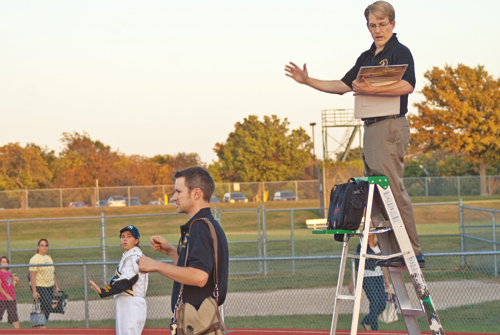
How do you help younger students to make progress?
I try to pair younger students with upperclassmen. Students love helping each other and it is not quite as intimidating as sitting down with the head director. We are trying to do more with ensembles. They can play together and help each other that way. We let the kids pick who they want to play with and I find music for them. I want it to be student directed so we don’t step in until it gets close to contest time. They work out the kinks on their own and develop leadership skills.
We are also fortunate to be able to pull in top players to work with other students who may be struggling in a particular area. These ten-minute lessons are a great way to foster camaraderie. When we first came here there was a strong sense of family in the music program. Students don’t mind helping each other. They may spend 30 minutes or an hour helping a buddy while I might have only had time for 10 minutes. Sometimes, students have found that the players they help beat them in auditions; the student has become better than the teacher. That happens all the time in college and in the real world.
How did your trip to London go?
We participated in the London New Year’s Day parade. We planned the trip for about 18 months and were there for five days with two days of travel. There were not too many surprises because we had been there before. Originally all of the luggage and instruments were going to be shipped on the plane. About a month before the trip, we were told to ship some of our equipment. We had to deal with shipping logistics in addition to normal luggage.
I called the airport in advance to let them know we would be coming with 170 people plus luggage and instruments. I asked the station manager for the airline if I could bring out some of the instruments early and she was happy to help.
The biggest problem occurred before the parade. We had about two hours to wait after the buses dropped us off. As soon as we stepped off, it started to rain. The buses were two miles away at the end of the parade and with half a million people watching the event there was no way to walk anywhere. I hadn’t thought about bringing raingear.
We marched in uniforms, full plumes and everything. When we returned to the hotel that night, I told them to throw away the plumes. They took their uniforms off and hung them separately. The next day we packed up the boxes for the return trip. When the boxes arrived back at school, the uniforms were still wet and now full of mold. Thanks to a great dry cleaner, I think we saved most of them.
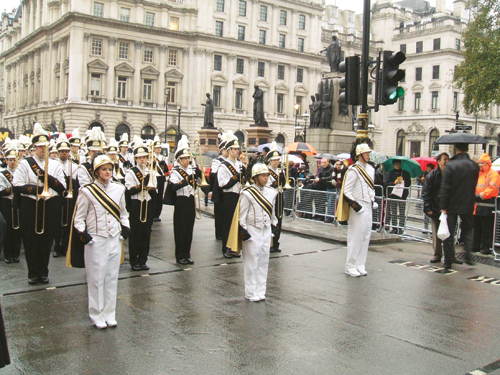
What are the biggest fundraisers that you use to support the program?
Our biggest fundraiser of the year is a spaghetti dinner and auction. Profit on that is usually about $10,000. It takes a great deal of time, so we started to explore some other options to raise money. Several years ago, I hosted the Count Basie band when I was teaching out in Dodge City. We only broke even, but it was a great opportunity for students to work with some top professional players. Kansas City is still a jazz hotbed so there is jazz every night of the week all over town. When my assistant and I came here in 2006 we had an idea for our two jazz bands to produce a winter ball. They prepared three hours of music from the 1940s and 1950s. The last couple of years we haven’t done as well with it so we are trying to figure out how to infuse life into the event. A local music retailer suggested bringing a big name, national artist. I love thinking big and was excited when my friend suggested the Glenn Miller Big Band. because we were trying to make the big band dance just like the Glenn Miller era. We hope to sell out our 1,000 seat auditorium with tickets at just $20 each and also include clinics to allow students to learn from these top players.
We have done some big car washes with pledge sheets and raised $10,000 instead of $1,500. Students take a sheet and people can pledge what they want. Those who pledge money receive a coupon for a free car wash on the day of the event. We usually divide the band into groups at three different locations and wash about 300 cars. If you collect pledges in advance, you receive much more money. I have had students earn $300-400 from one pledge sheet. It becomes serious money with no overhead.
Have you had any disastrous fundraisers?
A few years ago we made temporary tattoos of our school mascot to sell at games. The cost to make them was 25 cents a piece, and we sold them for a dollar. I still have a bunch left over. The jazz band once tried to sell pencils that smelled like pina colada, strawberry, cinnamon and other flavors. They were awesome, but we couldn’t sell them to save our lives. The first 200 took six months to sell.
How do you instill a sense of community in a program?
I talk often with section leaders about making younger students feel welcome when they come to the school. When we have band camp in the summer, I spend a half a day talking with the sections leaders about how to make the freshmen feel welcome and relaxed. They need to know that their section leader is a friend. I stress the importance of learning the names of the freshmen and finding out what activities they are involved in at school. We play all sorts of team-building games to get students joking and comfortable with band. These help everybody see the value of working together for one goal.
When we break for lunch, section leaders make sure their sections know how to get there. We ask them to invite the younger students to join them at lunch. The flutes and clarinets will bring in baked goodies for the section although the percussionists never do this. However, the camaraderie of band camp carries over to the rest of the year. Students have to feel wanted in band or they will feel that band doesn’t matter. Even during concert band, I encourage the section leaders to keep their ears to the ground. If something is going on, I want to know about it. We help each other all the time.
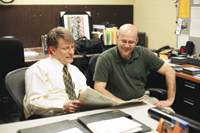 I also have a great administration that is very supportive of what we do and our philosophy. My assistant band director has a strong jazz background, so he runs the lead jazz ensemble and I run the second jazz band. In a lot of respects we are co-directors. The buck stops with me, but if I ever have to leave school for something, I have no qualms with him in charge. The parents are tremendous. I am part of a great team. I truly feel I couldn’t be as successful without the people around me. Even though we are in a metropolitan area of 2-3 million people near Kansas City, I still feel like I am living in the small town of 500 people where I grew up. We have all grown together.
I also have a great administration that is very supportive of what we do and our philosophy. My assistant band director has a strong jazz background, so he runs the lead jazz ensemble and I run the second jazz band. In a lot of respects we are co-directors. The buck stops with me, but if I ever have to leave school for something, I have no qualms with him in charge. The parents are tremendous. I am part of a great team. I truly feel I couldn’t be as successful without the people around me. Even though we are in a metropolitan area of 2-3 million people near Kansas City, I still feel like I am living in the small town of 500 people where I grew up. We have all grown together.
